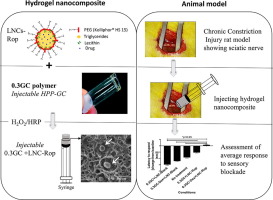Acta Biomaterialia ( IF 9.4 ) Pub Date : 2018-05-25 , DOI: 10.1016/j.actbio.2018.05.038 Manakamana Khanal , Shalini V. Gohil , Emmanuel Kuyinu , Ho-Man Kan , Brittany E. Knight , Kyle M. Baumbauer , Kevin W.-H. Lo , Joseph Walker , Cato T. Laurencin , Lakshmi S. Nair

|
Musculoskeletal pain is a major health issue which results from surgical procedures (i.e. total knee and/ or hip replacements and rotator cuff repairs), as well as from non-surgical conditions (i.e. sympathetically-mediated pain syndrome and occipital neuralgia). Local anesthetics, opioids or corticosteroids are currently used for the pain management of musculoskeletal conditions. Even though local anesthetics are highly preferred, the need for multiple administration presents significant disadvantages. Development of unique delivery systems that can deliver local anesthetics at the injection site for prolonged time could significantly enhance the therapeutic efficacy and patient comfort. The goal of the present study is to evaluate the efficacy of an injectable local anesthetic nanocomposite carrier to provide sustained analgesic effect. The nanocomposite carrier was developed by encapsulating ropivacaine, a local anesthetic, in lipid nanocapsules (LNC-Rop), and incorporating the nanocapsules in enzymatically crosslinked glycol chitosan (0.3GC) hydrogels. Cryo Scanning Electron Microscopic (Cryo SEM) images showed the ability to distribute the LNCs within the hydrogel without adversely affecting their morphology. The study demonstrated the feasibility to achieve sustained release of lipophilic molecules from the nanocomposite carrier in vitro and in vivo. A rat chronic constriction injury (CCI) pain model was used to evaluate the efficacy of the nanocomposite carrier using thermal paw withdrawal latency (TWL). The nanocomposite carriers loaded with ropivacaine and dexamethasone showed significant improvement in pain response compared to the control groups for at least 7 days. The study demonstrated the clinical potential of these nanocomposite carriers for post-operative and neuropathic pain.
Statement of significance
Acute or chronic pain associated with musculoskeletal conditions is considered a major health issue, with healthcare costs totaling several billion dollars. The opioid crisis presents a pressing clinical need to develop alternative and effective approaches to treat musculoskeletal pain. The goal of this study was to develop a long-acting injectable anesthetic formulation which can sustain a local anesthetic effect for a prolonged time. This in turn could increase the quality of life and rehabilitation outcome of patients, and decrease opioid consumption. The developed injectable nanocomposite demonstrated the feasibility to achieve prolonged pain relief in a rat chronic constriction injury (CCI) model.
中文翻译:

可注射的纳米复合镇痛剂输送系统,用于肌肉骨骼疼痛的管理
肌肉骨骼疼痛是一个主要的健康问题,它是由手术程序(例如,全膝和/或髋关节置换和肩袖修复)以及非手术情况(例如,交感神经引起的疼痛综合症和枕神经痛)引起的。当前,局部麻醉剂,阿片类药物或皮质类固醇用于肌肉骨骼疾病的疼痛管理。即使局部麻醉剂是高度优选的,但多次给药的需求仍存在明显的缺点。可以在注射部位延长麻醉时间的独特给药系统的开发,可以显着提高治疗效果和患者舒适度。本研究的目的是评估可注射局部麻醉剂纳米复合载体提供持续镇痛作用的功效。通过将局部麻醉药罗哌卡因封装在脂质纳米胶囊(LNC-Rop)中,然后将纳米胶囊掺入酶促交联的乙二醇壳聚糖(0.3GC)水凝胶中来开发纳米复合载体。低温扫描电子显微镜(Cryo SEM)图像显示了在水凝胶中分布LNC的能力,而不会对其形态产生不利影响。这项研究证明了从纳米复合材料载体中持续释放亲脂性分子的可行性。低温扫描电子显微镜(Cryo SEM)图像显示了在水凝胶中分布LNC的能力,而不会对其形态产生不利影响。这项研究证明了从纳米复合材料载体中持续释放亲脂性分子的可行性。低温扫描电子显微镜(Cryo SEM)图像显示了在水凝胶中分布LNC的能力,而不会对其形态产生不利影响。这项研究证明了从纳米复合材料载体中持续释放亲脂性分子的可行性。体外和体内。使用大鼠慢性收缩损伤(CCI)疼痛模型,通过热爪退缩潜伏期(TWL)评估纳米复合材料载体的功效。与对照组相比,载有罗哌卡因和地塞米松的纳米复合材料载体在疼痛反应方面至少显着改善了7天。该研究证明了这些纳米复合材料载体在术后和神经性疼痛中的临床潜力。
重要声明
与肌肉骨骼疾病相关的急性或慢性疼痛被认为是主要的健康问题,医疗保健费用总计数十亿美元。阿片类药物危机提出了迫切的临床需求,需要开发替代和有效的方法来治疗肌肉骨骼疼痛。这项研究的目的是开发一种长效的可注射麻醉剂,该制剂可以长时间维持局部麻醉作用。反过来,这可以提高患者的生活质量和康复结果,并减少阿片类药物的消费。所开发的可注射纳米复合材料证明了在大鼠慢性收缩损伤(CCI)模型中延长疼痛缓解的可行性。











































 京公网安备 11010802027423号
京公网安备 11010802027423号